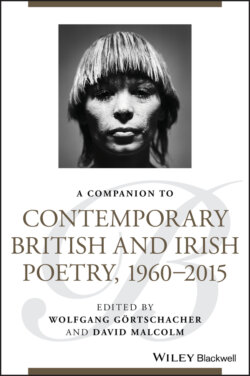Читать книгу A Companion to Contemporary British and Irish Poetry, 1960 - 2015 - Группа авторов - Страница 27
Robert Sheppard, “Fucking Time: Six Songs for the Earl of Rochester” (Dated 1992) (Sheppard 2004, 24–27)
ОглавлениеThis appears to be, on one level, a quite Rochesterian piece—it is lewd throughout—and, on another, not at all, for it seems quite disorderly—an antithesis to Rochester's polished pentameters. Ambiguity is embedded in the title. The songs for Rochester do not look Rochesterian or like songs. The first part of the title is triply ambiguous: “fucking time” means time for fucking; it means contemptible and vexatious time; and it means that this poem is messing about with, screwing over, kicking the butt of time.
Although the sequence as a whole is made up of the same number of stanzas with the same number of lines, the layout of the piece is nontraditional and certainly non‐Rochesterian. Lines are centered. Although there is a degree of similarity, lines are of substantially varied lengths and have varied numbers of principal stresses. There is much enjambment—for example, of the 12 lines of the first song, 7 run on, including the lines that end and begin all the stanzas (apart from line 1, that is). There is little rhyme, apart from that in stanza 1 in poem 6. Song 2 has metaleptic deletions. Nothing could be more different from Rochester's neoclassical technique.
But the subject matter is overtly Rochesterian, revolving around sex, physicality, disease, corruption, the bestial, and use of the body and others for advancement and sordid delectation. Even the fountains piss (song 2, line 1). There is much of dildoes, dog turds, and restless mares (song 3). Indeed, there is a kind of deviant ordering to the poem. The presence of local alliterations and consonance is unignorable. Most lines only vary between two and three main stresses. Forty five of the sequence's 72 lines end in unstressed syllables; trochees occur in 34 lines. The alliteration is part of Rochester's patterning in his verse, but the profoundly non‐iambic rhythm is not. This poem is at once a telling hommage to the great seventeenth‐century libertine poet, and yet a piece couched in a modern, innovatory idiom, yet with its own sly and disruptive patterning.
